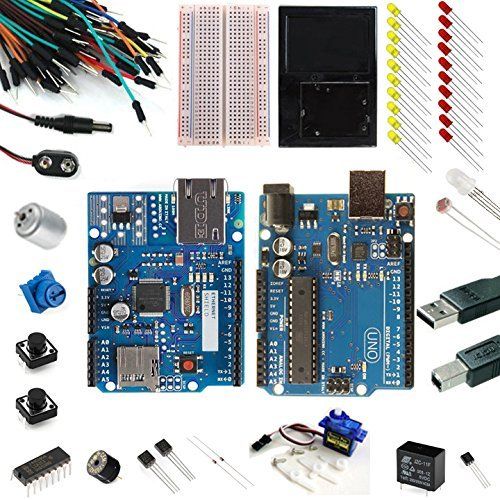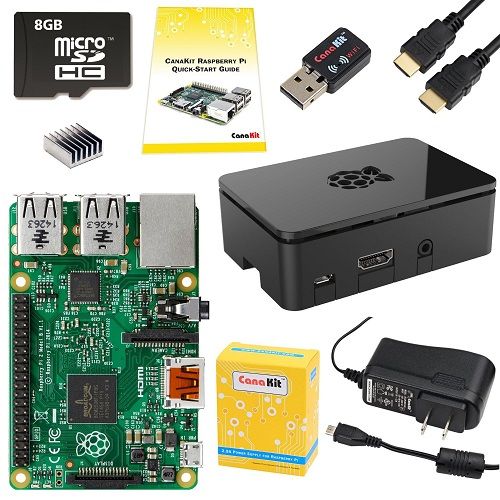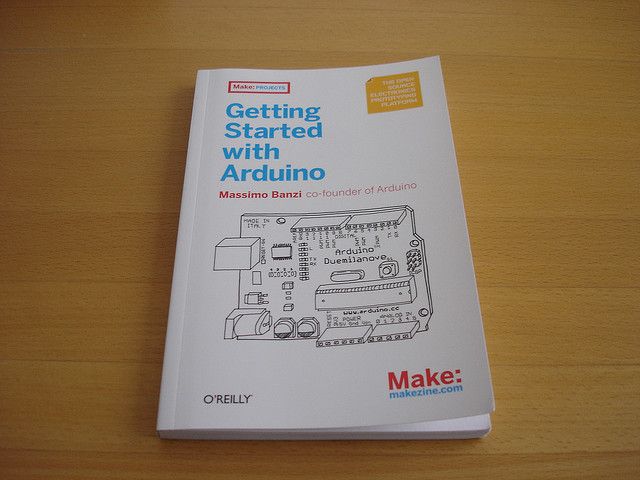Got a maker in the family, and haven't got the faintest clue of what you'll be getting them for Christmas? Don't stress.
From books, to starter kits and Arduino shields, this list has something for hardware hackers of every ability level.
Arduino Ultimate Starter Kit and Ethernet Shield
Being a maker can be an expensive hobby. This goes doubly true when you're starting out for the first time, and you have to purchase all the components and microcontrollers you need to actually build something. But as this kit proves, you don't necessarily have to break the bank.
It includes an Arduino Uno, and veritable smorgasbord of wires, resistors, capacitors, piezo buzzers, and breadboards. This is what you'd expect from an Arduino Starter Kit.
But this one also includes an Arduino Ethernet Shield, which allows you to build Internet of Things projects that get online through a wired connection, as well as a complimentary 72-page guide to Arduino.
The booklet has been described as being poorly written and unreliable by a number of reviewers on Amazon – but even with that excluded, this kit represents great value for money. You can order one for the low price of $69.99.
CanaKit Raspberry Pi 2 Complete Starter Kit
Next up, we've got another starter kit. This one's for the Rasperry Pi 2, and (very nearly) includes all you need to get started with the Raspberry Pi.
There's a WiFi dongle; an HDMI cable; a 2.5A USB power supply; an 8GB Class 10 MicroSD card with the NOOBS operating system pre-installed; a heat-sink (you almost certainly don't need this); two quick-start guides; and a sturdy plastic case with lid that can be removed, should you need to access the GPIO ports.
How much for all this? A paltry $69.99. Get it while you can, folks.
Getting Started with Arduino: The Open Source Electronics Prototyping Platform (Make)
Make Magazine is one of the most widely-known and respected maker publications on the planet. You'll be pleased to know their books are just as good, too.
What makes Getting Started with Arduino so special? Well, it's written by Massimo Banzi, who actually co-founded the Arduino project, as well as Michael Shiloh, who teaches electronics and robotics at the California College of the Arts. From the get-go, you know it's going to be factually accurate and incredibly detailed.
A copy of this book sits on my bookshelf. What I like about it is how gentle it is. It doesn't make any assumptions about the reader, and guides them by the hand through various different Arduino projects of ever-increasing complexity.
You can order a copy from Amazon for $15.62.
Designing the Internet of Things
I should probably preface this section with a bit of throat-clearing. Full disclosure: I actually know the authors of this book on a personal level. We all live in the same city, and at some point, we actually shared an office space together at our local hackerspace. Oh, and I'm mentioned in the book's acknowledgements section.
But believe me when I say despite that, I really like this book. If you've read Make's Getting Started with Arduino, this is the logical next step forwards. It looks at building Internet of Things products at a lower level, and introduces platforms other than Arduino, including Raspberry Pi and BeagleBoard.
Readers gain a deeper understanding of how individual components can combine to create compelling, interactive hardware devices.
But it takes a giant leap beyond merely explaining the technical facets of hardware design. The authors – Adrian McEwan and Hakim Cassimally -- explore how you can take your idea, and transform it from a simple handmade proof of concept, into something that eventually reaches mass production. As we've explored in the past, this is easier said than done.
You can order a copy on Amazon for $22.85.
1Sheeld
Last year, I went to the TechCrunch Disrupt conference in London. I was there to meet startups and makers, and to discover new products to write about. One in particular caught my eye.
It was called the 1Sheeld, and it allowed any Arduino to use the sensors and radios from any connected smartphone as though they were directly connected as a hardware shield.
So, for example, you could build a robotic arm that tilts its orientation in line with your phone, or an LED cube that lights up when you speak a specified command into your mobile phone. We reviewed it late last December, and were suitably impressed.
Initially it was only available to those who backed it on KickStarter, but now you can get it on Amazon for just $54.94.
Emgreat Motor Robot Car Chassis Kit and SainSmart L293D Motor Driver
If you had a remote control car growing up, you're going to love this. The Emgreat Motor Robot Car Kit provides the fundamentals of what you need to create your own RC car. It comes with a power supply (which takes 4 AA batteries); three wheels, with the rear two driving the car; and four GPIO cables.
For some reason, Emgreat also throw in a complimentary lens cloth with each purchase. No, I don't know why.
You can order the chassis for $11.59 from Amazon. But to actually to get it to move and steer in a meaningful way, you're going to need to a computer to control it (read: An Arduino), and some motors to drive it.
You can get the latter with the SainSmart L293D Motor Drive Shield, which costs $8.52.
Here are some more DIY robot kits you might want to consider.
60 Watt Soldering Iron
No tinkerer's toolbox is complete without a soldering iron. They're handy if you're building larger, more ambitious hardware products, or simply performing some repairs.
A friend of mine, for example, saved himself around $500 by repairing his broken mobile phone, rather than buying a new one. His SIM socket was detached from the main phone circuit board, preventing him from making or receiving phone calls, and using his data service. To fix it, he applied a liberal serving of molten solder.
Learning to solder is easy, and the irons themselves are rather cheap, too. One of the highest rated ones on Amazon can be had for only $7.99.
Sugru
Sugru is pretty rad.
It's essentially a pliable, self-setting rubber that's sturdy, waterproof, and elastic. By using your hand, you can twist and contort it into any shape you want, allowing you to do anything from ruggedizing tablet computers, to repairing broken headphones. Think of it as a really futuristic version of Plasti-Tack.
It's not that expensive, either. An eight-pack will set you back $22.00 on Amazon.
Any Other Recommendations?
Okay folks. We've seen eight incredible gifts for makers, tinkerers, and hardware hackers. But did I miss anything? Tell me about in the comments below.





